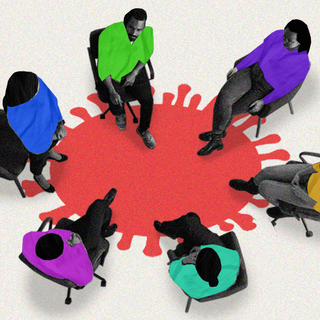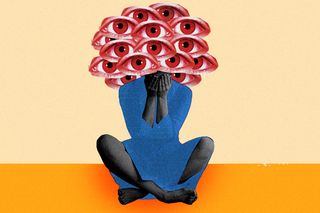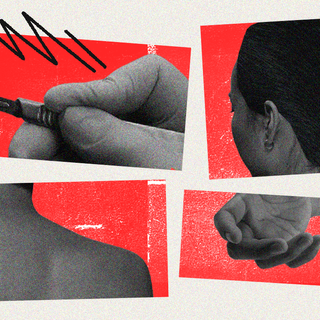
All You Need to Know About Social Anxiety
Pop culture representations belie the seriousness of social anxiety and how it can change the way people lead their lives.

Thanks to pop culture and a social tide organized around extroversion, social anxiety gets a bad rep. Nay, an uncool rep. More unflattering than just plain shyness, social anxiety is an affliction most often represented in the media in the form of sweating, stammering nerds who get shoved into lockers and are woefully unsuccessful in love. Such representations, though, belie the seriousness of social anxiety and how it can change the way people lead their lives.
Social anxiety is one kind of anxiety disorder characterized by an intense fear of social situations, judgment, and external perception. “The defining feature of social anxiety disorder, also called social phobia, is intense anxiety or fear of being judged, negatively evaluated, or rejected in a social or performance situation. People with [a] social anxiety disorder may worry about acting or appearing visibly anxious (e.g., blushing, stumbling over words), or being viewed as stupid, awkward, or boring,” the Anxiety and Depression Association of America notes. People with social anxiety can go to great lengths to avoid social situations and, where unavoidable, experience great distress. The condition, known as Social Anxiety Disorder (SAD) is thus life-altering and can often be debilitating for those who experience it.
SAD, moreover, is more common among younger people — and recent studies show its prevalence growing among young adults globally. A review across seven countries showed that one in three respondents met the criteria for SAD, with people between the ages of 18 to 24 most at risk. Many young people in India, moreover, report finding social media to be a helpful compensatory socializing tool. Research has also found that social anxiety has a prevalence rate of 7.8% among Indian undergraduates — and Internet-based intervention strategies for these individuals show promise.
What SAD doesn’t mean is that individuals living with it are loners. “They do want to make friends, they want to be included in groups, but having this anxiety becomes an obstacle in the way of doing so,” Dr. Kedar Pandya, a Mumbai-based psychologist, told The Swaddle.
While situations involving larger than average stakes — such as job interviews, dates, presentations, and public speaking — can be anxiety-inducing for anyone, only some people meet the diagnostic criteria for SAD. According to the Diagnostic and Statistical Manual of Mental Disorders V (DSM V), a person has SAD if their anxiety disrupts their life, influences their personal choices, and lasts for longer than six months. The DSM V classifies social anxiety as part of a spectrum of anxiety disorders — along with separation anxiety, specific phobias, selective mutism, and others.
Related on The Swaddle:
For People With Social Anxiety Disorder, Everyday Interactions Are a Source of Fear
Unlike how it can be portrayed, SAD is a serious and debilitating illness with high relapse rates, and a condition that can also lower one’s quality of life. Research shows that it has a worse impact on social functioning than other mental illnesses like depression and other chronic illnesses. Depression and other anxiety disorders can be comorbid conditions associated with SAD.
For all this, there’s little clarity on what causes SAD. “It could be genetics, trauma or environmental, or circumstantial situations as well… Both, chronic and continuous stress can lead to a person suffering from SAD, and lately, office stress is known to be one of the aggravators, too,” Dr. Sadanand Palve, also a Mumbai-based psychologist, told The Swaddle.
There is also a gender gap prevalent here. Research shows that women are more likely to have SAD and with greater clinical severity, while men are more likely to be treated for it. These finding calls for gender-sensitive interventions, researchers argue.
The ways to address social anxiety are manifold, but among them, cognitive behavioral therapy (CBT) emerges as the most effective form of treatment for SAD, according to experts. Some people may be prescribed anti-anxiety medication in addition to psychotherapy.
However, the condition also forces us to look outward and ask questions about many social norms cemented over time. In her book Quiet: The Power of Introverts in a World That Can’t Stop Talking, Susan Cain explains how many norms around work, relationships, leisure, and even spirituality have evolved over time to contain an extrovert bias. While not all introverts have social anxiety, many people with social anxiety are likely to be introverts. Given the overlapping Venn diagram between the two, the findings are instructive in what they tell us about how our world can be kinder and more accommodating for everyone.
Related on The Swaddle:
All You Need To Know About Avoidant Personality Disorder
Research has also backed the fact that cultural contexts play an important role in how anxiety disorders play out. Social anxiety’s symptoms, for instance, are positively correlated with interdependent self-construal — which means that a person’s sense of self is associated with their interconnectedness with their social groups and less autonomy. Asian countries — and India in particular — are known for collectivist cultures where people have an interdependent self-construal, making the likelihood of symptoms higher.
Moreover, research has also found that shame is a powerful component of social anxiety — and is valued highly in women as a behavioral norm in India. One study found a relationship between social anxiety in girls and parenting styles in India — showing that authoritarian, uninvolved, verbally hostile, and indifferent parental behaviors were positively correlated with social anxiety in girls. On the other hand, autonomy-granting and authoritative parenting styles had an inverse relationship with social anxiety.
But some other research on the impact of culture on social anxiety is contradictory. It shows that collectivist cultures show lower rates of social anxiety. Yet, the study also makes the case for symptoms to be evaluated in a culture-specific manner.
Overall, social anxiety is a condition that many argue needs to be taken more seriously — to improve treatment outcomes and people’s quality of life. It also ought to be regarded with more empathy and compassion. In this context, it is worth considering what Sartre once famously said and is endlessly misquoted for — “hell is other people.”
Rohitha Naraharisetty is a Senior Associate Editor at The Swaddle. She writes about the intersection of gender, caste, social movements, and pop culture. She can be found on Instagram at @rohitha_97 or on Twitter at @romimacaronii.
Related


All You Need to Know About ‘Math Dyslexia’
